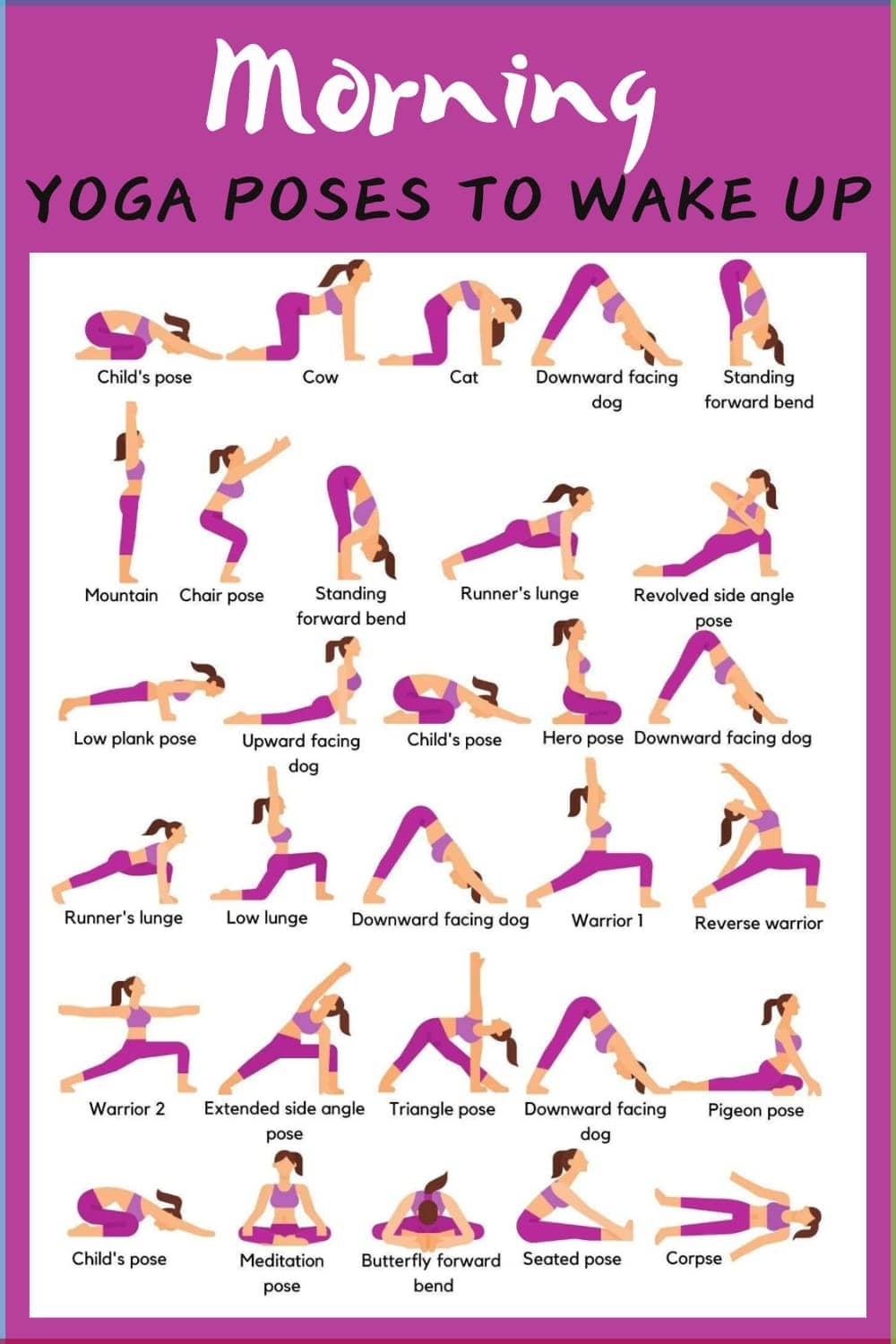Elevate Your Mornings: A Comprehensive Guide to Yoga Poses That Energize, Revitalize, and Inspire
Are you looking for a holistic way to start your day with mindfulness and vitality? A consistent morning yoga routine may be the key to unlocking greater flexibility, better focus, and a calm yet energized mindset. In this article, we’ll explore a variety of yoga poses specifically designed to help you wake up, shake off drowsiness, and set a positive tone for the day ahead.
Table of Contents
- Why Practice Morning Yoga?
- Essential Tips Before You Begin
- Detailed Breakdown of 20+ Morning Yoga Poses
- Child’s Pose (Balasana)
- Cow Pose (Bitilasana)
- Cat Pose (Marjaryasana)
- Downward Facing Dog (Adho Mukha Svanasana)
- Standing Forward Bend (Uttanasana)
- Mountain Pose (Tadasana)
- Chair Pose (Utkatasana)
- Runner’s Lunge
- Revolved Side Angle Pose (Parivrtta Parsvakonasana)
- Low Plank Pose (Chaturanga Dandasana)
- Upward Facing Dog (Urdhva Mukha Svanasana)
- Hero Pose (Virasana)
- Low Lunge (Anjaneyasana)
- Warrior I (Virabhadrasana I)
- Reverse Warrior (Viparita Virabhadrasana)
- Warrior II (Virabhadrasana II)
- Extended Side Angle Pose (Utthita Parsvakonasana)
- Triangle Pose (Trikonasana)
- Pigeon Pose (Kapotasana Variation)
- Meditation Pose (Easy Seat / Sukhasana)
- Butterfly Forward Bend (Baddha Konasana)
- Seated Pose Variations
- Corpse Pose (Savasana)
- Additional Tips to Maximize Your Morning Yoga Benefits
- Frequently Asked Questions (FAQ)
- Conclusion
Why Practice Morning Yoga?
Morning yoga has numerous physical, mental, and emotional benefits:
- Enhanced Circulation and Energy Levels
Gentle stretching and mindful movement increase blood flow throughout the body, helping you feel more alert and invigorated. - Calm, Focused Mindset
Yoga encourages you to focus on your breath and the present moment. This mindfulness practice helps alleviate stress and anxiety, setting a tranquil foundation for your day. - Improved Flexibility and Strength
By regularly practicing a variety of poses, you’ll gradually enhance your range of motion. Many yoga asanas (poses) also build muscle strength and endurance, supporting good posture and balance. - Better Mood and Emotional Well-Being
Yoga, especially when coupled with mindful breathing, can positively influence your mental well-being. By reducing stress hormones and increasing “feel-good” chemicals, morning yoga fosters a positive mindset for the day. - Convenient, Natural Wake-Up Routine
Morning yoga acts like a natural cup of coffee—awakening both the mind and body without the jitters. It’s a gentle, holistic approach to feel ready to tackle the day’s challenges.
Essential Tips Before You Begin
- Hydration
Drink a glass of water when you wake up to rehydrate from your overnight fast. This helps prepare your body for movement. - Comfortable Environment
Choose a quiet and clutter-free area, if possible. Use a yoga mat to support your knees and hands. Ensure there’s enough space to fully extend your limbs. - Gentle Warm-Up
Although many yoga poses gently warm up your body, spending a minute or two loosening stiff joints—such as rolling your shoulders and wrists—helps prevent strains. - Mind Your Breath
Inhale and exhale consciously through your nose whenever possible. Deep, even breathing increases oxygen flow and supports relaxation. - Listen to Your Body
Avoid pushing into pain. Yoga should challenge you, but it should not hurt. If a pose is too difficult, modify it or skip it until you build the necessary strength and flexibility. - Stay Consistent
For best results, practice at least three to four times a week. Consistency is key to reaping long-term benefits like improved flexibility, strength, and mental clarity. - Consult a Professional
If you have any medical concerns or chronic conditions, consult a healthcare professional before beginning a new exercise routine.
Detailed Breakdown of 20+ Morning Yoga Poses
Below, we’ll explore each pose featured in the infographic and discuss how to do it properly, its benefits, and modifications to suit different skill levels.
1. Child’s Pose (Balasana)
How to Do It:
- Kneel on the mat, bringing your knees either hip-width apart or wider for more comfort.
- Sit back on your heels.
- Lower your torso forward, allowing your forehead to rest on the mat.
- Extend your arms out in front or place them alongside your body.
Benefits:
- Stretches the lower back, hips, and thighs.
- Helps calm the mind and reduce stress or anxiety.
- Gently opens the shoulders.
Modifications:
- Place a cushion or folded blanket under your knees if you feel discomfort.
- Keep knees closer together if you prefer a more supported variation.
2. Cow Pose (Bitilasana)
How to Do It:
- Start on all fours, with knees hip-width apart and hands under shoulders.
- Inhale, arch your back, let your belly drop toward the mat.
- Lift your head and chest while gazing forward.
Benefits:
- Warms up the spine and neck.
- Improves posture by engaging the core and opening the chest.
- Stimulates internal organs.
Modifications:
- Place padding under your knees if needed.
- Keep the motion slow and controlled, synchronizing with your breath.
3. Cat Pose (Marjaryasana)
How to Do It:
- From Cow Pose, exhale and round your spine upward.
- Pull your belly button in toward your spine.
- Tuck your chin slightly, letting your head move toward the floor.
Benefits:
- Stretches the back, shoulders, and neck.
- Massages abdominal organs.
- Relieves tension in the spine.
Modifications:
- If you have sensitive wrists, make fists or place forearms on the mat for support.
- Maintain gentle transitions between Cow and Cat to avoid strain.
4. Downward Facing Dog (Adho Mukha Svanasana)
How to Do It:
- Begin on hands and knees.
- Lift your hips up and back, straightening the legs if possible.
- Press your palms firmly into the mat, spacing your fingers comfortably.
- Keep your spine long, shoulders relaxed away from the ears.
Benefits:
- Elongates the spine and strengthens arms, shoulders, and legs.
- Helps relieve lower back tightness.
- Improves circulation to the head, which can be invigorating in the morning.
Modifications:
- Bend your knees slightly if your hamstrings are tight.
- Practice against a wall for additional support if you’re a beginner.
5. Standing Forward Bend (Uttanasana)
How to Do It:
- Stand tall in Mountain Pose (Tadasana).
- Hinge at your hips, folding your torso forward.
- Let your arms, shoulders, and head relax toward the floor.
- Keep a micro-bend in your knees if needed.
Benefits:
- Stretches the hamstrings and calves.
- Relaxes the neck and spine.
- Stimulates the digestive organs.
Modifications:
- Use blocks or rest your hands on your shins if touching the floor is challenging.
- Bend your knees more deeply to accommodate tight hamstrings.
6. Mountain Pose (Tadasana)
How to Do It:
- Stand with feet together or hip-width apart.
- Engage the legs by lifting the kneecaps slightly.
- Roll shoulders back and down, letting your arms rest naturally.
- Lengthen your spine and lift the crown of your head up.
Benefits:
- Improves posture and alignment.
- Strengthens the legs and core.
- Serves as a foundational pose for many standing poses.
Modifications:
- If standing for long periods is uncomfortable, gently shift your weight between feet.
- Close your eyes and focus on your breath to enhance balance and mindfulness.
7. Chair Pose (Utkatasana)
How to Do It:
- Stand in Mountain Pose.
- Inhale, lifting your arms overhead.
- Exhale and bend your knees as if sitting back into a chair.
- Keep your chest lifted and weight in your heels.
Benefits:
- Strengthens thighs, calves, and ankles.
- Builds core stability.
- Energizes and warms up the entire body.
Modifications:
- Keep hands at heart center if raising arms overhead is too intense.
- Reduce the bend in your knees if you feel strain or discomfort.
8. Runner’s Lunge
How to Do It:
- From Standing Forward Bend, step one foot back.
- Bend your front knee to a 90-degree angle, aligning knee over ankle.
- Extend your back leg straight, balancing on the ball of your foot.
- Keep your torso lifted or place hands on the ground for support.
Benefits:
- Opens the hips and stretches the hip flexors.
- Strengthens your quadriceps and glutes.
- Improves balance and stability in the lower body.
Modifications:
- Place your back knee on the mat if you need extra support.
- Use blocks under your hands if reaching the ground is difficult.
9. Revolved Side Angle Pose (Parivrtta Parsvakonasana)
How to Do It:
- From Runner’s Lunge, place the opposite arm on the outside of your front knee.
- Rotate your torso, bringing your top shoulder back.
- Extend your top arm overhead or place your hands in prayer position at the heart center.
- Keep your gaze up if it’s comfortable on your neck.
Benefits:
- Strengthens and stretches the legs, hips, and spine.
- Improves digestion through gentle twisting action.
- Enhances balance and focus.
Modifications:
- Lower your back knee to the floor for stability.
- Use a block to support your lower hand if it does not comfortably reach the mat.
10. Low Plank Pose (Chaturanga Dandasana)
How to Do It:
- Begin in a high plank (push-up) position.
- Shift forward on your toes.
- Bend your elbows, keeping them close to your sides.
- Lower your body until it’s parallel to the floor.
Benefits:
- Strengthens the arms, shoulders, and core.
- Develops stability and proper alignment for more advanced yoga poses.
- Improves overall upper body endurance.
Modifications:
- Lower your knees to the floor.
- Decrease the depth of your push-up if you can’t maintain proper form.
11. Upward Facing Dog (Urdhva Mukha Svanasana)
How to Do It:
- From Low Plank, shift your weight forward and straighten your arms.
- Lift your chest and the front of your thighs off the mat.
- Keep your shoulders away from your ears, gazing forward or slightly upward.
Benefits:
- Opens the chest and shoulders.
- Strengthens arms, wrists, and back muscles.
- Stimulates abdominal organs, improving digestion.
Modifications:
- If you lack upper-body strength, begin with a Cobra Pose (Bhujangasana) by keeping your hips on the mat.
- Keep a micro-bend in the elbows if fully extending them causes discomfort.
12. Hero Pose (Virasana)
How to Do It:
- Kneel with knees together, feet spread slightly wider than hip-width.
- Sit back onto your heels or on a block placed between your feet.
- Rest your palms on your thighs, maintaining a long spine.
Benefits:
- Stretches quads, knees, and ankles.
- Encourages good posture.
- Serves as a calming position to transition between more challenging poses.
Modifications:
- Use a yoga block or cushion between your heels for extra support.
- Maintain a slight forward tilt if your ankles are stiff.
13. Low Lunge (Anjaneyasana)
How to Do It:
- From a high plank or Downward Dog, step your right foot forward between your hands.
- Drop your left knee onto the mat and raise your torso upright.
- Lift your arms overhead, palms facing each other.
- Gently press your hips forward to deepen the stretch.
Benefits:
- Stretches the hip flexors, quads, and groin.
- Strengthens the core and stabilizes the lower body.
- Supports healthy posture by opening the chest.
Modifications:
- Place a folded blanket under your back knee.
- Keep your hands at your waist or heart center if lifting overhead is uncomfortable.
14. Warrior I (Virabhadrasana I)
How to Do It:
- From Low Lunge, lift your back knee off the mat.
- Turn your back foot out slightly (45-degree angle) and press the heel down.
- Bend your front knee over your ankle, raising your arms overhead.
- Keep your hips facing forward as much as possible.
Benefits:
- Strengthens the legs, ankles, and core.
- Stretches the hips and sides of the torso.
- Builds focus and stability.
Modifications:
- Practice near a wall for balance support.
- Take a shorter stance if you experience discomfort in your hips.
15. Reverse Warrior (Viparita Virabhadrasana)
How to Do It:
- Begin in Warrior II (feet wide, front knee bent, arms extended).
- Flip your front palm up, and on an inhale, sweep that arm overhead.
- Rest your back hand gently on your rear thigh.
- Keep your front knee bent and gaze up at your lifted hand.
Benefits:
- Stretches the side body and intercostal muscles.
- Builds lower-body strength and stability.
- Enhances shoulder and arm flexibility.
Modifications:
- Keep your back hand on your hip if resting it on your thigh causes strain.
- Maintain a shallower bend in your front knee if your legs fatigue quickly.
16. Warrior II (Virabhadrasana II)
How to Do It:
- Step your feet wide, around 3–4 feet apart.
- Turn your front foot 90 degrees and your back foot slightly in.
- Bend your front knee to 90 degrees if possible, stacking knee over ankle.
- Extend arms out in opposite directions, gazing over the front fingertips.
Benefits:
- Strengthens legs, glutes, and core.
- Improves stamina and stability.
- Opens the hips and chest.
Modifications:
- Decrease the distance between your feet for better balance.
- Rest your hands on your hips if raising arms causes discomfort.
17. Extended Side Angle Pose (Utthita Parsvakonasana)
How to Do It:
- From Warrior II, place your front forearm on your front thigh or a block.
- Extend your top arm overhead, creating a diagonal line from fingertips to back foot.
- Keep your chest open, gazing up under your top arm.
Benefits:
- Deeply stretches the waist, hips, and thighs.
- Strengthens the legs and abdominal muscles.
- Improves balance and concentration.
Modifications:
- Lower your front hand onto a yoga block if the floor is too far.
- Shorten your stance if you feel any knee strain.
18. Triangle Pose (Trikonasana)
How to Do It:
- Stand with feet 3–4 feet apart, front foot pointing forward, back foot angled slightly.
- Straighten your front leg (micro-bend in the knee if needed).
- Reach your upper body over the front leg and rotate your arms into a vertical line.
- Rest your lower hand on your shin, ankle, or a block, while your top arm extends up.
Benefits:
- Stretches and strengthens thighs, knees, and ankles.
- Opens the hips and chest.
- Improves digestion and spinal mobility.
Modifications:
- Keep a slight bend in your front knee to avoid hyperextension.
- Look down at the floor if looking up causes neck strain.
19. Pigeon Pose (Kapotasana Variation)
How to Do It:
- From Downward Facing Dog, bring your right knee forward behind your right wrist.
- Extend your left leg straight behind you.
- Keep your hips squared forward and lower your torso over your front leg.
- Rest your forearms or forehead on the mat for support.
Benefits:
- Deeply opens the hips and relieves lower back tension.
- Stretches the hip flexors and glutes.
- Can help alleviate sciatica in some individuals.
Modifications:
- Place a cushion or folded blanket under your hips for balance.
- Remain upright if folding forward is too intense.
20. Meditation Pose (Easy Seat / Sukhasana)
How to Do It:
- Sit on the mat, crossing your legs comfortably.
- Lengthen your spine and rest your hands on your knees or in your lap.
- Close your eyes, maintaining a relaxed but upright posture.
Benefits:
- Encourages mental clarity and calm.
- Helps reduce stress and anxiety.
- Fosters a sense of introspection and mindfulness.
Modifications:
- Sit on a cushion to elevate your hips.
- Support your back against a wall if needed.
21. Butterfly Forward Bend (Baddha Konasana)
How to Do It:
- Sit with the soles of your feet together, knees out to the sides.
- Clasp your feet or ankles.
- Gently fold forward from the hips.
- Keep your spine long; only go as far as comfortable.
Benefits:
- Stretches the inner thighs and groin area.
- Improves posture by elongating the spine.
- Relaxes the lower back when done gently.
Modifications:
- Place cushions under your thighs if they don’t naturally lower to the ground.
- Keep your torso upright if folding forward causes discomfort.
22. Seated Pose Variations
These poses can include simple twists or basic forward folds:
- Seated Forward Bend (Paschimottanasana):
Sit with legs extended, folding over them to stretch the hamstrings and lower back. - Seated Spinal Twist (Ardha Matsyendrasana):
Cross one leg over the other and twist your torso, looking over your shoulder.
Benefits:
- Increase flexibility in the spine and hamstrings.
- Help reduce tension in the lower back.
- Stimulate digestion through gentle twisting.
Modifications:
- Use a folded blanket under your hips for extra comfort.
- Bend knees slightly during forward bends to protect your lower back.
23. Corpse Pose (Savasana)
How to Do It:
- Lie flat on your back, arms relaxed by your sides, palms facing up.
- Separate your feet slightly, allowing them to drop outward.
- Close your eyes and focus on releasing tension from head to toe.
Benefits:
- Allows full relaxation of body and mind.
- Helps integrate the benefits of your yoga practice.
- Encourages deep, restful breathing.
Modifications:
- Place a rolled blanket under your knees if your lower back is sensitive.
- Use an eye pillow or small towel over your eyes to encourage deeper relaxation.
Additional Tips to Maximize Your Morning Yoga Benefits
- Combine Yoga with Breathwork
Simple breathing exercises like Alternate Nostril Breathing (Nadi Shodhana) or Box Breathing can help you center your mind and oxygenate your body before or after your practice. - Be Mindful of Nutrition
Practicing on a full stomach can be uncomfortable. Aim to do yoga on a relatively empty stomach or after a light snack like fruit or yogurt. - Set an Intention
Before you start your routine, choose an intention or mantra (e.g., “I will move today with calm and confidence”). This encourages a more purposeful practice. - Stay Consistent with Your Routine
Regular practice is crucial for long-term gains in flexibility, strength, and mental clarity. Even 10 to 15 minutes every day can have a significant impact. - Create a Peaceful Atmosphere
Soft, natural light in the morning is ideal. If you practice before the sun rises, consider using warm, low lighting or candles to enhance relaxation and focus. - Cool Down Properly
After finishing your morning yoga poses, spend a few moments in Savasana or Meditation Pose. This helps your body and mind absorb the benefits of your practice.
Frequently Asked Questions (FAQ)
1. How long should a morning yoga routine be?
A good starting point is around 10–20 minutes. Gradually increase this as your schedule allows and as your body adapts. Even a short session can make a big difference in how you feel throughout the day.
2. Can I drink coffee or tea before yoga?
It’s a matter of personal preference. Some people feel more comfortable practicing on an empty stomach, but a small amount of caffeine can help others feel alert. Just avoid heavy meals immediately before practice.
3. What if I’m not flexible?
Flexibility is not a prerequisite for yoga; it’s a benefit you gain from consistent practice. Start with gentle poses and use props like blocks, straps, and blankets to make each pose accessible.
4. Is morning yoga suitable for beginners?
Absolutely. Morning yoga can be highly beneficial for practitioners of all levels. Begin with basic poses like Child’s Pose, Cat-Cow, and Downward Facing Dog, and gradually explore more challenging poses as you grow more comfortable.
5. Can yoga replace my regular workout routine?
Yoga can complement many forms of exercise, improving flexibility, balance, and mental focus. Whether or not it replaces your existing routine depends on your fitness goals. Some people combine yoga with cardio or strength training for a well-rounded regimen.
6. Do I need special gear?
A non-slip yoga mat is helpful. You may want supportive clothing that doesn’t restrict movement. Blocks, straps, and cushions can also be beneficial, but they’re optional.
Conclusion
Morning yoga is a simple yet powerful practice that can revolutionize the way you start your day. From Child’s Pose to Corpse Pose, each asana serves a unique purpose in energizing your muscles, calming your mind, and preparing you to face life’s daily challenges with renewed vigor and focus. Whether you’re a seasoned yogi or a complete beginner, incorporating a few of these poses every morning is an excellent way to foster holistic wellness.
Remember to listen to your body, stay patient with your progress, and focus on the breath. Over time, you’ll likely notice increased flexibility, better stress management, and a radiant sense of well-being. As with any exercise routine, consider consulting a healthcare professional if you have any injuries or specific medical conditions.
May your mornings be filled with mindfulness, balance, and positive energy as you begin each day on your yoga mat. Namaste.










